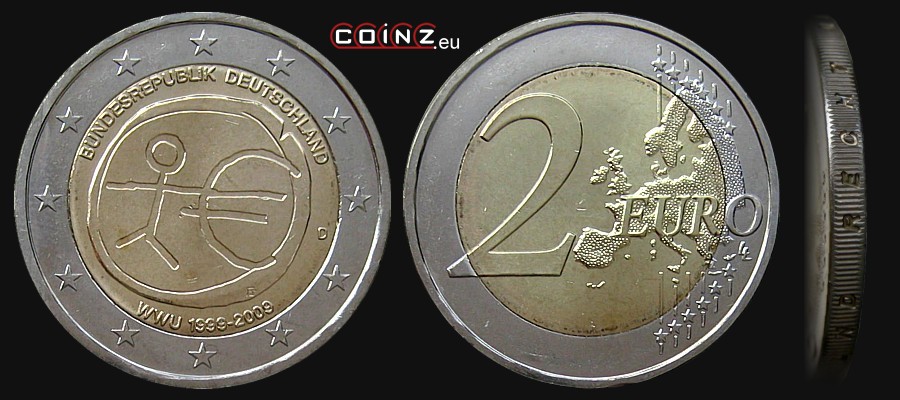2 euro GERMANY (2009) 10th Anniversary of Economic and Monetary Union


| diameter: | weight: | thickness: | alloy: |
| 25.75 mm | 8.5 g | 2.22 mm | Cu75Ni25/Cu75Zn20Ni5 |
obverse:
in the centre an irregular stylised planchet of an ancient coin; inside it a concave figure of a man, whose arm is a part of a euro currency symbol €; along the top edge: BUNDESREPUBLIK DEUTSCHLAND (Federal Republic of Germany); along the bottom edge: WWU 1999-2009 (WWU - Wirtschafts- und Währungsunion - Economic and Monetary Union); at the edge a ring of twelve five-pointed stars - symbol of the European Union
reverse:
edge:
reeded with concave inscription:
 (unity and justice and liberty and eagle from German Coat of Arms)
(unity and justice and liberty and eagle from German Coat of Arms)
 (unity and justice and liberty and eagle from German Coat of Arms)
(unity and justice and liberty and eagle from German Coat of Arms)
issue date:
1 I 2009
withdrawal date:
circulating
designer:
Γεώργιος Σταματόπουλος (initials ΓΣ above the date 2009 on the obverse), Luc Luycx (initials LL below letter 'O' in EURO on the reverse)
(Georgios Stamatopoulos, Luc Luycx)
(Georgios Stamatopoulos, Luc Luycx)
mint:
(A) Staatliche Münze Berlin (The State Mint Berlin), Berlin;
(D) Bayerisches Hauptmünzamt (The Bavarian Main Mint), Munich;
(F) Staatliche Münzen Baden-Württemberg (State Mints of Baden-Wuerttemberg), Stuttgart;
(G) Staatliche Münzen Baden-Württemberg (State Mints of Baden-Wuerttemberg), Karlsruhe;
(J) Hamburgische Münze (The Hamburg Mint), Hamburg
(relevant mint mark at the right edge of the obverse)
(D) Bayerisches Hauptmünzamt (The Bavarian Main Mint), Munich;
(F) Staatliche Münzen Baden-Württemberg (State Mints of Baden-Wuerttemberg), Stuttgart;
(G) Staatliche Münzen Baden-Württemberg (State Mints of Baden-Wuerttemberg), Karlsruhe;
(J) Hamburgische Münze (The Hamburg Mint), Hamburg
(relevant mint mark at the right edge of the obverse)
mintage:
| A | D | F | G | J | |
| 2009 | 6 000 000 + 60 000 * |
6 300 000 + 60 000 * |
7 200 000 + 60 000 * |
4 200 000 + 60 000 * |
6 300 000 + 60 000 * |
interesting facts:
In the contests for a design of a coin commemorating 10th anniversary of the Economic and Monetary Union, the proposal of George Stamatopoulos from the Central Bank of Greece has won the internet voting. He proposed the idea of a coin on a coin, which he had used previously on a Greek national obverse of 1 euro coins. There he introduced an irregularly struck Greek coin of 4 drachmas from 5th century BC. This time he designed by himself a coin pretending to be ancient. All euro zone members issued a coin with the same motif on the obverse. Let's meet the other finalists.


last update: 3 XII 2014
coins catalogue :: katalog monet :: münzkatalog :: catalogue de monnaies :: catálogo de monedas :: catalogo monete :: каталог монет :: κέρματα κατάλογος :: COINZ.eu
© 2010-2025 :: Adam Kubicki :: COINZ.eu :: All rights reserved.


